Najuban are small serving tables produced in Naju, South Jeolla Province. Master craftsman Kim Chun-sik has preserved their legacy, which had nearly disappeared after the 1940s. Quite by chance, Kim started researching the traditional table craft in the mid-1950s, and has now spent seventy years of his life protecting this cultural heritage.
Kim Chun-shik, designated a Master Artisan in the art of soban-making, has preserved and further developed the legacy of Naju soban, which was on the brink of extinction. Through the painstaking process of disassembling and reassembling hundreds of old tables, he was able to recreate the original form of the traditional tables from Naju.
Korea’s traditional wooden tables used for carrying or serving food are called soban (literally “small table”). In the Korean lifestyle of yore, shaped by the practice of sitting on the floor rather than chairs, this versatile piece of furniture was used for a variety of purposes, from everyday dining to ceremonial occasions. The soban tradition stretches deep into the nation’s history. The tables appear in various forms in Goguryeo tomb murals from the fifth and sixth centuries, while an oval-shaped version was found among pottery artifacts excavated from a tomb dating back to the Silla era (57 BCE–935 CE). According to Gyeongguk daejeon, the legal code of the Joseon Dynasty (1392–1910), there was a government office dedicated to the production of tables, the process divided into specialized procedures in order to create various styles.
There are some sixty kinds of soban, classified by place of origin, design, and function. They are particularly distinguished by regional characteristics: haejuban from Haeju, Hwanghae Province; najuban from Naju, South Jeolla Province; and tongyeongban from Tongyeong, South Gyeongsang Province. While Haeju and Tongyeong tables are known for their beautiful decorative carvings, those from Naju are more understated with an emphasis on sturdiness and simple elegance.
Various kinds of tables, called sang, carry profound cultural significance in Korea. In the past, women would wish for a child in front of a small table with a clean bowl of water placed on it. When waiting for a child to be born, they would set up a table of offerings for Samsin, the goddess of childbirth, to pray for a safe delivery. After the birth, tables laden with symbolic objects or food were prepared for the hundredth-day celebration and the first birthday to express wishes for the child’s health and happiness. Throughout life, specially prepared tables marked significant milestones, including birthdays, weddings, and the sixtieth birthday. Even the deceased were remembered every year with offerings set up on ritual tables. Many of these customs are still carried on today. Thus, for Koreans, tables are an essential element in the passage of life, from before birth until after death.
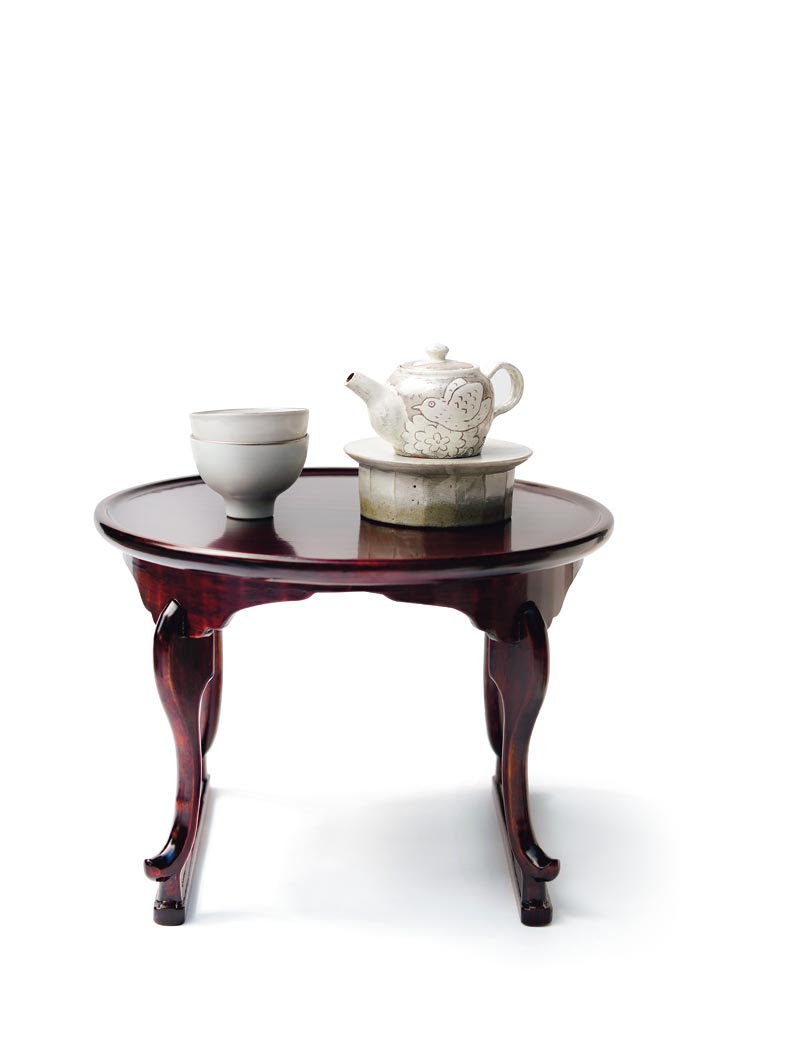
Circular Hojokban (Tiger-legged table). Pine wood. 36 × 36 × 26 cm.
Soban are known by various names depending on production region, shape, function, and material. The depicted hojokban features a round top. The legs are thick at the top and gradually taper toward the bottom, curving slightly upward at the ends. These tables are typically made of zelkova, pine, or ginkgo wood.
Courtesy of Soluna Craft Korea
TABLES FOR THE SEATED
The term sobanjang refers to both the craft of making soban and the artisans who practice it. Master craftsman Kim Chun-sik is recognized for restoring the traditional Naju-style soban, which had nearly vanished after the Japanese colonial period (1910–1945). As these small tables were mostly carried by women serving meals, they needed to be lightweight. This is why Kim primarily uses ginkgo wood, which is light yet sturdy, rather than zelkova, a widely used wood with a beautiful grain that is heavier.
“Soban was the most essential item in traditional Korean woodcraft,” Kim explains. “From the royal court to common households, it was used at all levels of society. Even servants received their meals on gaedarisoban [small tables with cabriole legs; gaedari, meaning ‘the hind legs of a dog’]. When beggars came asking for food, our custom was to serve them meals on a soban. No matter how humble the food, when served on an elegant soban, it never looks shabby.”
Kim emphasizes the culture embedded in soban, which goes beyond aesthetic appeal. In many other cultures, people come to the table to eat, but with soban, diners sit and wait for the table to be placed in front of them. In Korean culture, receiving a table means being respected and honored as an individual.
Kim says, “It’s nice to sit around a dining table together to eat, but you’ll understand when you serve a table to a family member who comes home late. There’s a significant difference between eating alone at a large dining table and receiving your own personal soban.”
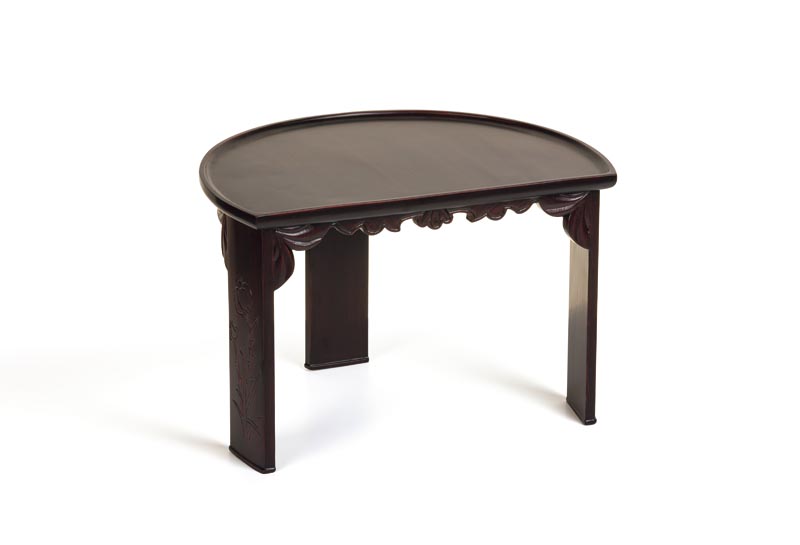
Banwolban (Half-moon table). Ginkgo wood. 43 × 31 × 28 cm.
Banwolban are small tables with a semicircular top and three flat, wide legs. They were used in combination with other tables or placed against the wall for decorative purposes.
Courtesy of Najuban Training Center

Najuban with Scroll Design. Ginkgo wood. 50 × 36 × 29 cm.
While najuban are simple tables, sometimes design elements are incorporated into the corner brackets. They are structurally sturdy and resistant to warping or cracking, which allows for relatively larger sizes. With their spacious tops, they were often used as desks.
Courtesy of Najuban Training Center
ADOPTING OLD TABLES AS TEACHERS
Kim’s path to becoming an artisan was far from conventional. Born in 1936, he began his craft later than most of his peers, who typically started as apprentices in their teens. Instead, Kim opened his own workshop in Yeongsan-po, Naju, in his early twenties, driven solely by the need to make a living. He did not train under a master but hired skilled craftsmen to produce and sell tables.
“A distant cousin of mine, who was a carpenter, passed his tools on to me with the advice that making tables would provide a stable living,” Kim recalls. “So I just opened a workshop. Back then, every household had at least one small table, even if they couldn’t afford a wardrobe.”
In those days, skilled woodworkers would travel the country, moving from one workshop to another in search of better conditions. Kim learned the craft by observing the artisans he hired, but he was essentially a woodcraft merchant — until he received a special order not long after opening his workshop.
“One day, a client from Seoul arrived with an unusual request. They had lost an ancestral ritual table, crafted in Naju and passed down in the family for generations. They asked me to recreate it, providing detailed sketches and even an advance payment, saying they would wait as long as necessary.”
Lacking the skill required for the project, Kim initially sought out Yi Un-yeon (1895–1972), the last known najuban master. Yi was the son of the celebrated artisan Yi Seok-gyu (1866–1940), whose work was highly praised in Joseon and Its Art (Chōsen to sono geijutsu), written by Japanese folk art scholar Yanagi Muneyoshi, who had been fascinated by colonial-era Korean art. Alas, Yi Un-yeon had grown quite old and had already retired.
In the end, Kim was unable to fulfil the client’s request. However, he decided to use this setback as an opportunity to study the original form of najuban. Without a teacher to guide him, he first began advertising that he could repair old tables. Soon, tables that had been stored away began to arrive one by one. While the craftsmen in his workshop produced ordinary tables, Kim rented a barn and focused on repairing the antiques, disassembling and reassembling them in the process.
“Back then, most well-off households in this region had one or two antique Naju tables. So I had plenty of artifacts to study and repair. After working on these tables for over ten years, I was able to make my own najuban. Those antique tables were my true teachers.”
FINDING FULFILLMENT
Like other traditional Korean wooden items, soban are made without using metal nails. The process begins with drawing the shape of the tabletop on a wooden board, using a template. The tabletop is then cut and planed. Kim stresses that planing is the crucial first step that determines the quality of the completed table.
The next step is making the rim (byeonjuk), which prevents the tabletop from warping or cracking. Unlike tables from Haeju and Tongyeong, which have rims carved into the tabletop, on Naju tables the rims are made separately and fitted into a groove. Next, decorative corner brackets (ungak) connecting the tabletop to the legs are carved and fixed using bamboo nails and adhesives for reinforcement — a unique feature of Naju soban. The brackets typically feature cloud or scroll designs. The legs are then crafted and fitted to the brackets. To ensure stability, parallel footrest bars (jokdae) connect each pair of legs at the bottom and prevent the table from wobbling. Finally, horizontal braces (jungdae) are added on all four sides between the corner brackets and footrest bars.
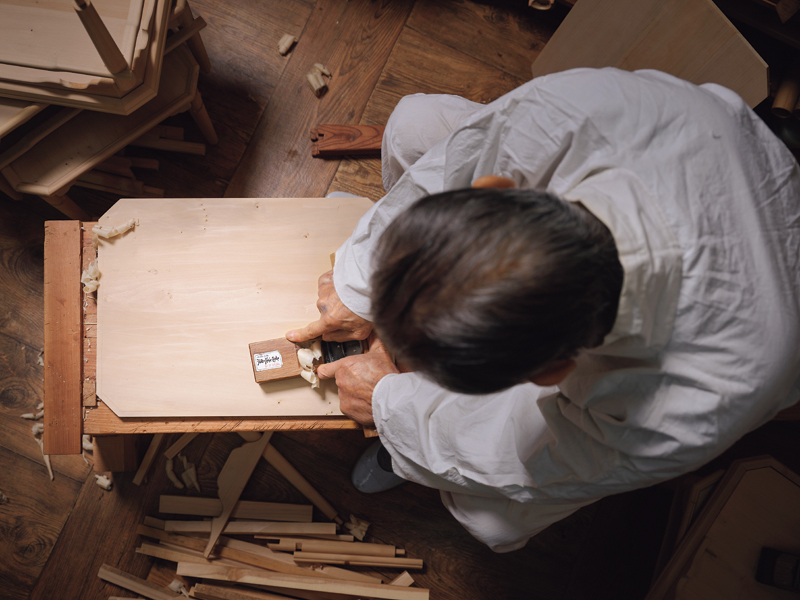
To make the tabletop, Kim cuts the wood to size, planes it, and then smooths the grain with sandpaper.
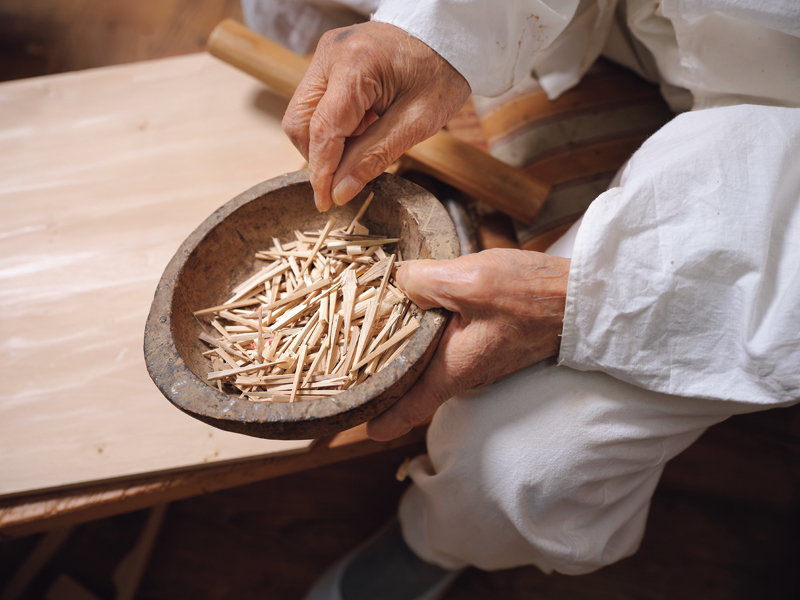
Bamboo nails are used to attach the corner brackets to the tabletop. Typically, four bamboo nails are used for each bracket.
Once the bare wooden table is made, it is finished with seven or eight cycles of lacquering, drying, and sanding. Kim takes particular pride in his lacquerwork techniques. Lacquer not only protects the wood against moisture but also creates a subtle, beautiful luster that intensifies with time. In all, it takes forty to sixty days to make a single table.
In 1977, Kim held an exhibition of seventy Naju tables at the Gwangju Student Center. This exhibition was a success and attracted significant media attention. Nevertheless, Kim’s workshop faced constant financial struggles. Like many other traditional artisans, Kim found that preserving ancient techniques was financially challenging. His once thriving workshop, which employed 18 craftsmen, was occasionally at risk of being seized, while some of his work had to be put up for auction.
“Whenever good wood becomes available, I have to buy it regardless of the cost, even if it means going into debt. But the wood must be left to age for over ten years before it can be used. Our wood inventory literally represents our debt burden,” Kim says.
The craftsman closed his commercial workshop after being designated as a Master Artisan of soban-making, which was included on the list of Intangible Cultural Heritage of South Jeolla Province in 1986. Since then, Kim has committed himself solely to training students and creating his own work. Having lost his father at a young age and completed only elementary school, Kim says he fulfilled his desire for learning by studying and preserving the najuban tradition. In 2011, he fulfilled his long-cherished wish by opening the Najuban Training Center, complete with an exhibition hall and workshop. Three years later, he received state-level recognition as a Master Artisan of soban-making, a National Intangible Cultural Heritage. Kim has also resolved the question of succession: his youngest son among his five children, Kim Young-min, is now an instructor for successors to the art — a position qualified by Korea’s intangible cultural heritage system — thereby carrying on his father’s legacy.
Though now approaching his nineties, Kim continues his work. When asked to reflect on his long journey as an artisan, he pauses, his eyes welling up with tears, and remains silent for a while. Yi Sang-sun, Kim’s wife of 62 years, passed away on December 9, 2024.
“My wife deserves the greatest credit for everything I’ve achieved,” he says finally. “She passed away recently. It seems we truly understand the value of our treasures only after losing them.”
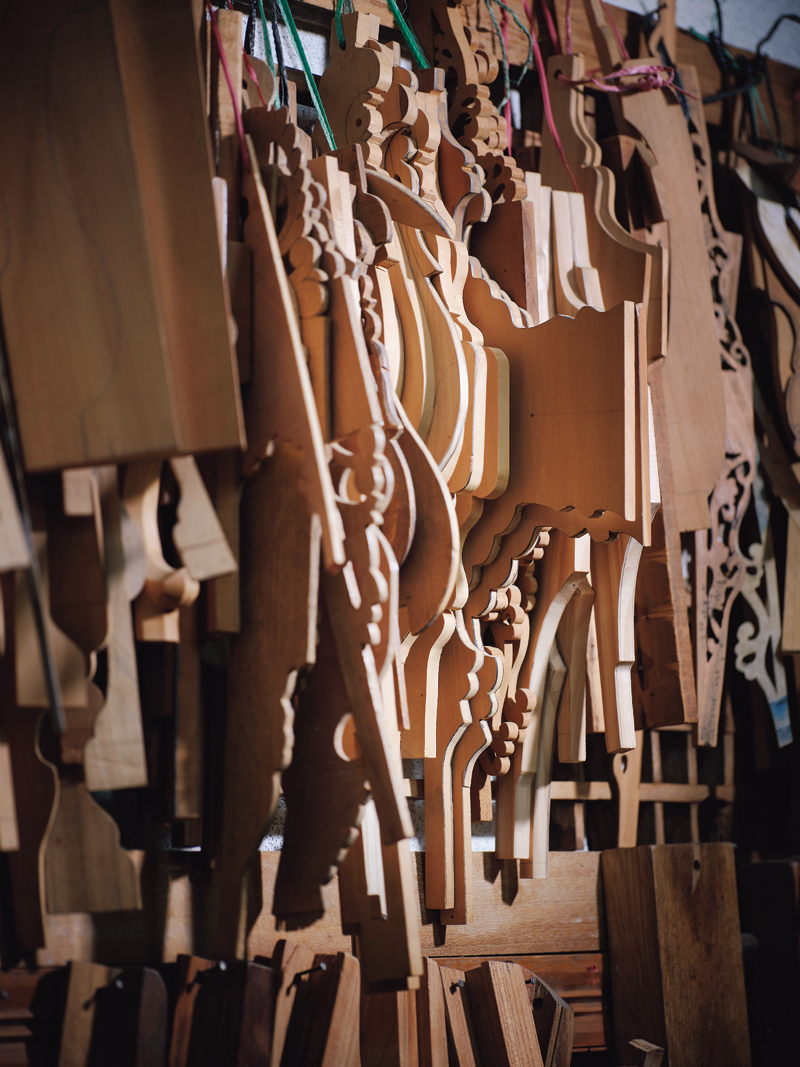
Corner brackets carved in various shapes hang on the wall. The designs most commonly found in the corner brackets of najuban are clouds and scrolls. Typically, two pairs of corner brackets are used regardless of the tabletop shape.